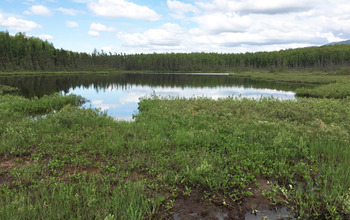Global S&T Development Trend Analysis Platform of Resources and Environment
| NSF awards $14.7 million for research to deepen understanding of Earth’s biodiversity | |
| admin | |
| 2017-09-14 | |
| 发布年 | 2017 |
| 语种 | 英语 |
| 国家 | 美国 |
| 领域 | 气候变化 ; 地球科学 ; 资源环境 |
| 正文(英文) |  NSF Dimensions of Biodiversity grantees will study Campbell Lake and nearby peatlands in Alaska.
Symbiotic bacteria -- microbes that have close and long-term relationships with their "hosts" -- are everywhere on Earth: in soil, in coral reefs, in humans. Through a new National Science Foundation (NSF) Dimensions of Biodiversity grant, scientist Joel Sachs of the University of California, Riverside, will look at native California legume plants and their symbiotic nitrogen-providing bacteria, as well as at the soil in which the plants are rooted, to determine the magnitude of the benefits the bacteria provide. Sachs plans to educate farmers on plant-microbe interactions. His research will guide how microbes may be used to increase the productivity of agricultural systems. The project is one of seven funded this year through the Dimensions of Biodiversity program, a unique research initiative that integrates multiple areas of study, in contrast to traditional biodiversity studies that focus on one taxonomic group or ecosystem. The program is part of NSF's Environmental Research and Education (ERE) portfolio. A total of $15.2 million has been invested in the awards, $14.75 million from NSF's Directorate for Biological Sciences and $450,000 in co-funding from the National Natural Science Foundation of China. "These awards showcase the creativity of scientists and the power of biology to understand the rules by which communities of organisms form, interact and change through time," says James Olds, NSF assistant director for Biological Sciences. "The projects examine global-scale gradients in biodiversity and the eco-evolutionary feedbacks between coexisting species and their environments in new and transformative ways." The Dimensions of Biodiversity program links functional, genetic and phylogenetic dimensions of biodiversity, offering opportunities to produce rapid advances in understanding the creation, maintenance and loss of biodiversity. The research will fill gaps in biodiversity knowledge, scientists say. It also has the potential to lead to significant progress in agriculture, fuel, manufacturing and health. For example, plant and animal extinctions are detrimental to human health, researchers have found. Species losses in ecosystems such as forests and fields result in increases in pathogens, or disease-causing organisms. The species most likely to disappear as biodiversity declines are often those that buffer infectious disease transmission. Those that remain tend to be ones that magnify diseases such as Lyme disease. Economic sustainability also depends on the diversity of life on Earth. Many industrial materials, such as fibers and dyes, come from biological sources. In addition, biodiversity is important to water, food and pharmaceuticals. To conserve Earth's biodiversity, scientists funded through the Dimensions of Biodiversity program are working to better understand interactions between, for example, plants and insects. The 2017 Dimensions of Biodiversity projects focus on topics that include: genome structure and adaptive evolution in peat mosses as ecosystem engineers; biotic and abiotic (such as water and soil) drivers of Central and South American plant speciation, whereby one species becomes two; and determining why insects are tolerant of potent toxins in plants they consume. 2017 NSF Dimensions of Biodiversity Awards James Bever, University of Kansas Center for Research Inc.: Dimensions US-China: Collaborative Research: Microbe eco-evolutionary feedbacks as drivers of plant coexistence and diversity gradients Gregory Bonito, Michigan State University: Dimensions: Phylogenetic and functional diversity of tripartite plant-ungal-bacterial symbioses Tadashi Fukami, Stanford University: Dimensions: Collaborative Research: Assembly and function of nectar microbial communities Kathleen Kay, University of California, Santa Cruz: Dimensions: Collaborative Research: Biotic and abiotic drivers of Neotropical plant speciation Laura Reed, University of Alabama, Tuscaloosa: Dimensions: Collaborative Research: Integrating phylogenetic, genetic, and functional approaches to dissect the role of toxin tolerance in shaping Drosophila biodiversity Joel Sachs, University of California, Riverside: Dimensions: Collaborative Research: Elucidating the drivers of mutualism variation in host-symbiont metapopulations A. Jonathan Shaw, Duke University: Dimensions: Collaborative Research: Genome structure and adaptive evolution in peatmosses (Sphagnum): ecosystem engineers -NSF- |
| URL | 查看原文 |
| 来源平台 | US National Scientific Foundation (NSF) |
| 文献类型 | 新闻 |
| 条目标识符 | http://119.78.100.173/C666/handle/2XK7JSWQ/126065 |
| 专题 | 气候变化 地球科学 资源环境科学 |
| 推荐引用方式 GB/T 7714 | admin. NSF awards $14.7 million for research to deepen understanding of Earth’s biodiversity. 2017. |
| 条目包含的文件 | 条目无相关文件。 | |||||
| 个性服务 |
| 推荐该条目 |
| 保存到收藏夹 |
| 查看访问统计 |
| 导出为Endnote文件 |
| 谷歌学术 |
| 谷歌学术中相似的文章 |
| [admin]的文章 |
| 百度学术 |
| 百度学术中相似的文章 |
| [admin]的文章 |
| 必应学术 |
| 必应学术中相似的文章 |
| [admin]的文章 |
| 相关权益政策 |
| 暂无数据 |
| 收藏/分享 |
除非特别说明,本系统中所有内容都受版权保护,并保留所有权利。
修改评论